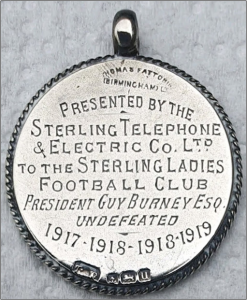
Sterling Ladies FC Medal
1917-1918 + 1918-1919
UNDEFEATED
Source: Author’s Collection
36 Games Undefeated
In Part 1 of this series [to read click HERE] I gave an overview of the Sterlings, their unique record and range of opponents. To be a truly great football team you need to have played truly great opposition. In this article I will start to explore in detail some of their opposition, especially the Chelmsford ‘scene’.
Marconi – “The Wizard of the Air”
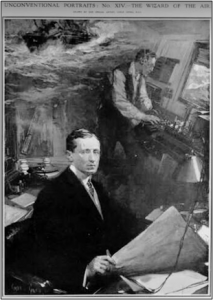
GUGLIELMO MARCONI
The originator of the Marconi system of wireless telegraphy, which has enabled ships in mid-ocean to communicate with land
Source: BNA Illustrated London News Saturday 6 August 1910 p11
1910 Profound Technical and Social Change
Prior to the start of World War 1 enormous technical and social change was taking place. Witness the following piece in the Illustrated London News:
“The exciting chase of Dr. Crippen, wanted for the presumed murder of his wife, had more than anything else, with the exception of the famous case where the “Republic” sent the message of “C.Q.D.,” brought home to the man in the street the modern marvel of wireless telegraphy. Chevalier Marconi’s mother was an Irishwoman, and he was born in Bologna on April 25, 1874. He married the daughter of Lord Inchiquin, the Hon. Beatrice O’Brien, in 1905. His first experiments in wireless telegraph were made at Bologna, where he studied at the University. In 1899 he established wireless communication across the channel, between France and England, and his system is now used in the British and Italian navies, and at various stations on land, over distances up to 1000 miles. He was the first to receive, in 1901, wireless messages across the Atlantic – 2100 miles – from Poldhu, in Cornwall, to St. John’s, Newfoundland. The Marconi system is now in use on more than 120 ships of the Mercantile Marine. In 1907 he established a wireless service for public use across the Atlantic, between England and America.
NB: The White Star Liner ‘Republic’ sank off Nantucket in 1909. Fortunately the Liner had the new Marconi wireless system and was able to transmit CQD (Come Quickly, Distress) and 2,000 lives were saved.
The Chelmsford Women’s Football ‘Scene’
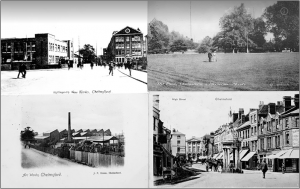
Chelmsford in WW1 – Hoffmanns, Marconi, Arc Works (Cromptons)
Source: Lizzy Ashcroft Collection
Chelmsford – Vital to the War Effort
During World War 1 Chelmsford was home to four enormous and vitally important factories which provided engineering for the war effort and employed large numbers of women – Hoffmanns, Marconi, Cromptons and National Steam Car Company. Chelmsford is famous today for its association with Guglielmo Marconi and wireless. In 1899 Marconi opened the world’s first radio/ wireless factory on Hall Street in Chelmsford. This had grown into a very large and successful business by WW1. Crompton’s (known as the ‘Arc Works’) produced vitally important electrical generators and motors. Hoffmanns, which produced ball bearings, was of incredible importance to the war effort. During the war the factory manufactured parts for tanks. At the time the Hoffmanns was bigger than Marconi and nothing mechanical would run without their vital products. National Steam Car Company was run by an innovative engineer Mr. T. Clarkson. By the start of WW1 his steam buses were a popular alternative to the smelly and smokey petrol buses and 200 were operating in the London area.
Chelmsford employed huge numbers of women workers during the war and Company Sports Days were a significant part of charity fundraising and letting off steam for their male and female workers. The women’s football ‘scene’ in Chelmsford formed a significant part of the 1,000+ games from the start of WW1 to the end of the 1918-1919 ‘war’ season.
The “Charity Model” Legitimises Women’s Football
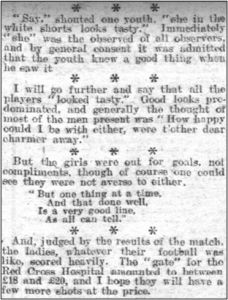
Red Cross Hospital £18-£20 Raised
Source: BNA Essex Newsman Saturday 10 March 1917 p1
“Say, she in the white shorts looks tasty”
On Saturday 3 March 1917 2,000 spectators turned up to Hoffmann’s ground in Coval Lane, Chelmsford to watch two inter-departmental football matches. The Essex Newsman Newspaper introduced its coverage with the statement:
“All roads in Chelmsford last Saturday led to Hoffmann’s ground in Coval Lane.”
The band of the Yorkshire Regiment entertained during the breaks. The scores were:
Hoffmann’s Viewing Dept 0 v 0 Hoffmann’s Turret Dept
Captained by MIss A. Bright and Mrs. E. Hughes
Hoffmann’s Magneto Shop 0 v 2 Hoffmann’s Ball Cutting Dept
Captained by MIss D. Cutts and Mrs. E. Bristowe
It is important to remember that in many ways that society was still very socially conservative and ‘Victorian’ in outlook. The 1902 English F.A. Ban on women playing football was still very much in force* and the overwhelming influence of the ‘charity model’ had not yet legitimised young women playing football. The Essex Newsman in its reporting of the games was starkly ‘off-message’. The starred contents above demonstrate the tone of the main article which points out that the players weren’t aware of ‘correct’ play, crowded together, used hands and had no idea of off-side. This tone changed very rapidly in the coverage by the Chelmsford newspapers. The standard of the football would obviously have rapidly improved with significant coaching and training, which we can assume took place.
*Read about the imposition of the 1902 ban at Fratton Park, Portsmouth in 1914 – Click HERE to read
1914 Footballs for Tommies
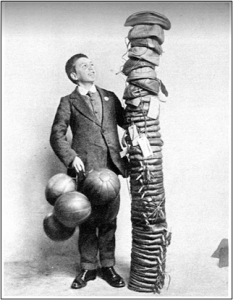
Footballs as ‘Suitable Gifts’ for Men at the Front
Source: BNA Illustrated War News Wednesday 16 December 1914 p32
1916-1919 Hoffmanns Ladies FC – “The Rollers”
Hoffmann Ladies FC had a lengthy football career and were known as ‘the rollers’ because of the manufacture of tank parts – “Play up the rollers!” In 1919 the Sterlings had a long journey over from Dagenham to Chelmsford to play Hoffmanns in their final game on 26 April to cement their place in history with their ‘invincibles’ reputation intact. By Saturday 24 March 1917 Hoffmanns had twice played in front of crowds of 2,000, once in the interdepartmental games and once to beat the Marconi Ladies by 2 goals to 1. Even the Essex Newsman was starting to be impressed:
“I am told there is no better present to our Tommies than a football, and if it has associations the more pleasure it gives. Now, I should think that the footballs which the dear girls at Hoffmann’s kick about in so attractive and charming a manner would have special value for the lads in khaki, and if after a set-to, between the lady footballers of floor this and department that, one of the balls (footballs, not those of the ball bearing sort) were sent to, say, the Essex Regiment, they would receive it with gusto. Your kick-off ladies.”
Hoffmanns finished off their 1916-1917 season with two games against the ‘Romford Girls’. The first game was played in Romford (result unknown) and the final game in Chelmsford. Almost nothing is known about this team.* In a tantalisingly brief match report the Chelmsford Chronicle records that despite being 2 – 0 down the Romford Girls triumphed 3 – 2, playing away at Hoffmanns!
*The Sterlings played Brocks Laundry (Romford) 5 months later on 29 September 1917
The Great Marconi Ladies FC – “The Reds”, “Wireless Girls”
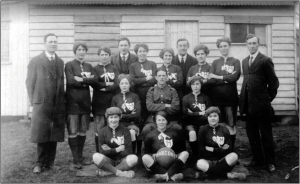
Marconi Ladies FC, Chelmsford, Essex
Source: Courtesy Patrick Brennan
Marconi – The only single team to Hold the Sterlings to a Draw
It is worth pointing out that only one defeat would have denied the Sterling’s their legendary status as “the invincibles”. The closest that this came to happening was their only two draws which were both in their first season. The second draw came in their penultimate game of the season against the gigantic Vickers company which had combined the best of their two teams, Crayford and Dartford into one. I will explore this game in detail in a further article. Interestingly, the other draw was against their arch rivals Marconi. They had met during the summer for a cricket match. This was only the fifth external game of the season for Marconi and the fourth for the Sterlings and they came very close to losing their legendary status…
Marconi – Season 1917-1918 – Played 18, Won 12 Drawn 5, Lost 1
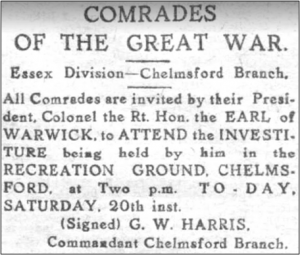
Investiture at Chelmsford – April 20th 1918
Followed by Ladies Football Match
Source: BNA Essex Newsman Saturday 20 April 1918 p4
The Great Marconi Ladies FC
There are several interesting points to note in this final game of Season 1917-1918 for the Marconi Ladies, apart from their magnificent record. The game followed the investiture (medal giving) ceremony at the Recreation Ground. They are now obviously part of the ‘establishment’ and it is quite an honour to be invited to provide the post-investiture entertainment. As well as the Lord-Lieutenant, the Earl of Warwick, the ‘sporting’ Baronet Sir Claude Champion de Crespigny (4th Baronet) from Maldon was there. This is also the point in WW1 when a lot of women’s football teams cease to play. The Essex Newsman had the following report about their season ending game (notice the complete change of tone):
“Ladies at Football – An interesting match followed the investiture on the Recreation Ground on Saturday, the Marconi Girls entertaining Braintree Manor Works. Braintree arrived short, and Miss Ketley, the late Marconi captain, assisted them in goal, and played a rattling game. The local goalie also was absent. The Reds pressed at the outset, and monopolised the play, but failed to score, although awarded a penalty kick for hands, Miss Ketley saving well. The game ended in a draw, no score being registered. The local girls’ defence was good, and Miss Johnson, ably led her forwards. The Marconi Girls’ record to date is: Played 18, won 12, drawn 5, lost 1; goals for 60, against 20.”
The Manor Works was the home of Crittalls Windows. Crittalls Windows is still going as a leading business with premises in Witham. The Manor Works in Braintree became famous for making steel windows, from starting off as an ironmonger’s shop in 1849. During WW1 the factory in Braintree was turned over to munitions production.
Season 1917-1918 Games
- 1917 Sat 13 October – Marconi 2 v 2 Sterling Ladies – Chelmsford (Coval Lane)
- 1917 Sat 20 October – Marconi 1 v 0 Yorkshire Batt Sergeants – Chelmsford (King’s Head Meadow)
- 1917 Sat 27 October – Marconi 9 v 0 Colchester – Colchester
- 1917 Sat 17 November – Marconi 3 v 3 Crittalls – Braintree (Manor Works)
- 1917 Sat 24 November – Marconi 7 v 0 Woolwich Arsenal – Chelmsford (Coval Lane)
- 1917 Sat 29 December – Marconi 2 v 1 Crittalls – Chelmsford (Coval Lane)
- 1918 Sat 1 February – Marconi 6 v 0 Midland Rail Co (Cricklewood) – Chelmsford (Coval Lane)
- 1918 Sat 9 March – Marconi 1 v 1 Orwell Ladies (Ipswich) – Chelmsford (King’s Head Meadow)
- 1918 Sat 16 March – Marconi 0 v 5 Sterling Ladies – Dagenham
- 1918 Sat 27 April – Marconi 0 v 0 Crittalls – Chelmsford (Recreation Ground)
“Sterling Telephone Works – A Crack Side”
Above are details of the 10 matches that I have been able to uncover so far. Both the Essex Newsman and Chelmsford Chronicle refer to the draw with the Sterlings by saying:
“On Saturday they entertained the Sterling Telephone Works, a crack side, and, although playing one short, effected a draw of 2 – 2.”
The heroine of the day for Marconi was Grace Johson, who scored both goals. Lengthier match reports in both the Sportsman and the Eastern Counties Times report that both teams showed considerable ‘pluck’ in playing through a heavy rainstorm with the Sportsman saying that they were:
“no milk and watery lot.”
Marconi Ladies played a range of women opponents which included the Sterlings, Colchester, Woolwich Arsenal, Midland Rail (Cricklewood) and Crittalls. It appears that Crittalls were a good footballing side, holding Marconi to two draws and a narrow 1 – 0 loss. It would be interesting to piece together their other games as the match report for the 27 April game reports: 18 played, 12 won, 5 drawn, 1 loss with goals for 60 and goals against.
So far I have found only one game in the 1918-1919 season. This was a 3 – 0 defeat of Midland Rail. There was talk of a game against Handley Page Ladies. Due to the ending of the war many women’s football teams saw their final 1918-1919 season ‘fizzle out.’
1917 October – National Red Cross – “Our Day”
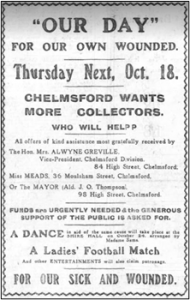
Chelmsford “Our Day” – A Ladies’ Football Match
And other ENTERTAINMENTS will also claim patronage
Source: BNA Chelmsford Chronicle Friday 12 October 1917 p1
Marconi 1 v 0 Yorkshire Battalion Sergeants
Thursday 18th October 1917 was designated national “Our Day” to fundraise for the Red Cross to support their work with wounded soldiers. The Essex Newsman reported that King George had contributed £10,000, the Queen £1,000, the Prince of Wales £3,000 and Queen Alexandra £1,000. Two Directors of ‘the well known Essex silk firm’ Courtaulds had offered to match £5,000 each if eight others could match and that this had happened. Both the Chelmsford Chronicle and the Essex Newsman carried the following report:
“Our Day, for the Red Cross Society, realised £127 10s. 7d. The effort was continued on Saturday by a football match between Marconi ladies and sergeants of a Yorkshire Batt. on the King’s Head meadow. The Mayor (Ald. J. O. Thompson, J.P.) kicked off. The sergeants played in skirts and kicked with their left feet. The ladies won an exciting and amusing match by a goal to nil, scored by Miss Johnson. The sergeants, in spite of their handicap of skirts, soon overcame their difficulties and played a good game, and the ladies goal had several narrow escapes. The ladies played exceedingly well and are a very useful side. C.S.M. Dean excelled at the back for the sergeants.”
The mixed game was followed by a military game: Yorks Regiment 5 v 0 Shoeburyness Garrison and the band of the Yorks Regt played during the intervals.
The Yorkshire Regiment was billetted at Widford, Chelmsford during the war. They were very supportive of the wider war effort, regularly supporting numerous fundraising matches by playing football against male and female teams and providing the musical accompaniment.
March 1918 – “The Blues” defeat “The Reds”
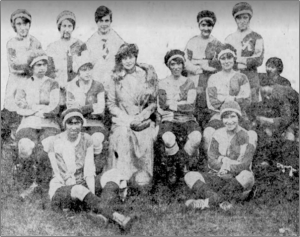
Sterling Ladies FC posing with Mrs Guy Burney
Source: Newspapers.com
A Riot of Colour
On Saturday 16 March 1918 Marconi’s in their splendid red kit surrendered to the invincibles of Dagenham in their iconic blue strip by 5 goals to nil. The Sportsman newspaper had this to say:
ASSOCIATION FOOTBALL
UNDEFEATED LADY FOOTBALLERS IN OPPOSITION
STERLING RETAIN THEIR UNDEFEATED RECORD
“On Saturday last on the ground of the Sterling Club at Dagenham, Marconi’s Chelmsford, visited the home club. Both held undefeated certificates, the previous meeting at Chelmsford resulting in a draw. A very fine game was witnessed by a numerous company. Playing at the very top of their form, the Dagenham team gained a well-deserved victory by five goals to nil, and for the fourth time this season retained their untarnished record by defeating an undefeated eleven.
The defence shared the honours with the attack, as the Marconi front rank has been in great form and has scored heavily on numerous occasions. Miss Marshall and Miss Green being very smart forwards.
The visitors’ vanguard were all good, but were not so well supported as were the Blues front rank, who tested Miss Monk very severely. Her goalkeeping was splendid, notwithstanding the five goals registered, as on several occasions she repelled some excellent shots, one from the home team’s captain being an exceptionally fine save.
The visitors several times were in the vicinity of the home gaol, and kept the defence ever on the alert. Only once, however, was the Blues goalkeeper severely tested, and she, like her colleagues, was not found wanting. If one player more than another in the defence, where all did so well, deserves mention it is the sprightly Vic Hale, as she had the visitors’ most dangerous wing to mark. In scoring five times against an undefeated team, the Sterling forwards once again demonstrated their knowledge of the location of the goal and their shooting prowess, the whole quintette contributing their quota to the success of the side. Both the extreme wingers found the net, and but for bad luck, or, rather, fine goalkeeping, each of the forwards would have credited herself with at least one goal, the Blues’ captain, A. Dixie, being most unfortunate in failing to defeat the visitors’ custodian. She, however, contributed in no small measure towards the success of the vanguard as an attacking force, who worked together with the rhythm of highly developed munition-making machines. The determining factors incidental to match-winning known as goals were scored as follows: – A. Segger, 1st; Maud Smith, 2nd; A. Fairman, 3rd; A. Tennyson, 4th; A. Fairman, 5th. But, as previously stated, the scores were merely instrumental in crowning the efforts of the excellent work accomplished by their confreres, who one and all assisted in the desired goal-culminating climax being achieved.
Teams
Sterling: The Misses G. Fairman, T. Peters, V. Foster, V. Hale, M. Reader, M. Billett, A. Segger, A. Tennyson, Maud Smith, A. Dixie (captain), A. Fairman.
Marconi’s: The Misses Monk, Everett (captain), Francis, Wilson, Attridge, Barrett, Banham, Green, Johnson, Hurrell, Marshall.
Referee, Mr. G. Peterson.
The Sterling Ladies FC had demolished their arch rivals Marconi in style at home. They had four remaining fixtures to complete the season. Three were very straightforward games but one would prove to be perhaps the sternest test of their entire careers. A high profile game was arranged to be played at Chalkwell Park, Southend-on-Sea on behalf of the war hospitals of Southend against the mighty and unbeaten Vickers Crayford, with its 14,000 employees. Vickers Crayford decided to augment its team with several players from another team, Vickers Dartford and an ‘exciting struggle’ was anticipated.
“The Only Way is Essex”
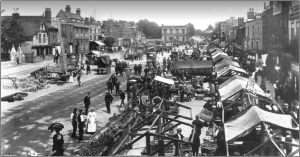
Romford Market, Essex c. 1908
Source: Lizzy Ashcroft Collection
Women Policing Women
On Friday 9 October 1914 the campaigning newspaper Common Cause reported that the National Union of Women Workers had approached the Home Secretary for permission to organise Women’s Patrols. They argued that the patrols were urgently needed because of the ‘many complaints’ as to the conduct of women and girls in the neighbourhood of military camps and recruiting stations. Unlike the quiet, relatively rural areas of Hornchurch and Dagenham, Romford was a thriving and busy market town. Here is part of an article which appeared in March 1918 in the Chelmsford Chronicle about such patrols in Romford and Brentwood:
“Following a request from the Romford Justices for women police patrols, the Chief Constable said
Romford and Brentwood were selected by the National Union of Women Workers by places in which
women patrols was likely to be of value in meeting the difficulties caused by women and girls of loose behaviour, and in April, 1915, the organisation was undertaken in Romford by Miss Blackwell and in Brentwood by Miss Philips. Considerable credit was due to these two ladies. At Romford some 40 ladies were supplied with patrol cards, and for about 18 months excellent and regular work was done. The patrols were received very kindly by the men, and no case of friction came to the notice of the police. In several cases the patrols were able to help quite young girls, and their work undoubtedly led to more self-respecting conduct. Unfortunately the demand for workers in every sphere had increased to such an extent that the organisation had to be abandoned. One outcome of the work remained, the Romford Girls’ Club, which was flourishing.”
108 years ago, in 1915 it was felt that 40 presumably older women were required to officially patrol Romford to watch for ‘loose behaviour’.
“Widow Welch’s Female Pills”
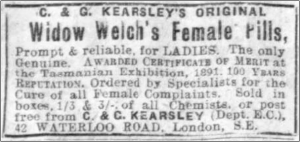
Advert for ‘Female Pills’
Source: BNA Chelmsford Chronicle Friday 30 March 1917 p2
Primitive Understanding of Women’s Physiology
It is important to highlight that over 100 years ago medicine was not as advanced as it is now. The understanding of the physiology of women was particularly primitive and many, many adverts could be seen which offered to cure a bewildering array of ‘female complaints.’ Above is just one example which happened to be next to a football article in the Chelmsford Chronicle
C & G. KEARSLEY’S ORIGINAL
Widow Welch’s Female Pills
Prompt & reliable, for LADIES. The only Genuine. AWARDED CERTIFICATE OF MERIT at the Tasmanian Exhibition, 1891. 100 YEARS REPUTATION. Ordered by specialists for the Cure of all Female Complaints. Sold in boxes, 1/3 & 3/-, of all Chemists, or post free from C. & G. KEARSLEY (Dept. E.C.), 42 Waterloo Road, London, S.E.
One can only hope that the pills were no more than a placebo or contained nothing more harmful than a little aspirin.
Chelmsford – A Very Special Place for Women in WW1
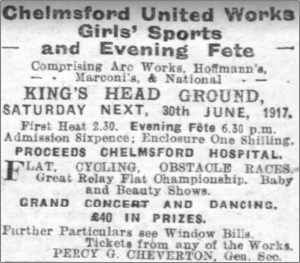
Chelmsford United Works Girls’ sports— and Evening Fete —
Source: BNA Essex Newsman Saturday 23 June p1
Four Huge Companies Holding a Large, High Profile Women’s Sports Day
Up and down the country there were fetes and sports days which often included sports for women. Often, this was how ‘ladies football’ became a legitimate thing to support and led to women’s football matches taking place outside of these events. Indeed, there were a number of other fetes involving the four companies in Chelmsford over this summer and the summer of 1918. However, it is my opinion that the above sports and fete dedicated to women is unique. I think that it also helps to demonstrate the extremely positive environment in Chelmsford which led to the success of the magnificent Marconi and Hoffmann’s Ladies Football Teams.
Conclusion to Part 2
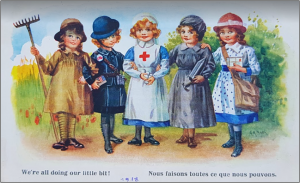
Land Girl, Clippy, Nurse, Munitionette, Postie
We’re all doing our little bit!
Nous faisons toutes ce que nous pouvons.
Source: Lizzy Ashcroft Collection
Role of Women
The fact that enormous, seismic technological and social change took place and was accelerated considerably (and unnaturally) by World War 1 is easy to say. I think that it is much harder to picture what life was like for the average or typical young working class woman over 100 years ago. Socially we were still very much in the Victorian era in attitude and those attitudes would have been deeply ingrained in a lot of people. The role of older and perhaps higher social status women in policing and controlling the lives of young working class women in their social behaviour and sporting efforts needs further exploration and acknowledgement.
It has been my privilege to bring the magnificent ‘Chelmsford Scene’ to wider prominence for us to appreciate the Marconi Ladies, Hoffmanns Ladies, Cromptons Ladies, National Steam Car Ladies and their sporting efforts. The football matches uncovered so far record games against the Sterlings, Crittalls Ladies of Braintree, Woolwich Arsenal Ladies (the ‘Dreadnoughts’), Colchester Ladies, Midland Rail Co Ladies of Cricklewood, Orwell Ladies of Ipswich and the Romford Girls. I believe and hope that there are more games to be found.
The Marconi Ladies FC (“The Wireless Girls”, “The Reds”) deserve their place in history. Rather like the Blyth Spartans of Northumberland they appeared to have flowered for just over one full season, THE 1917-1918 war season. When they retired and went on with the rest of their lives they could forever say: “We went toe to toe with the Dagenham Invincibles and held our own.” They should be very proud and we should be very proud of them.
Article © Steve Bolton

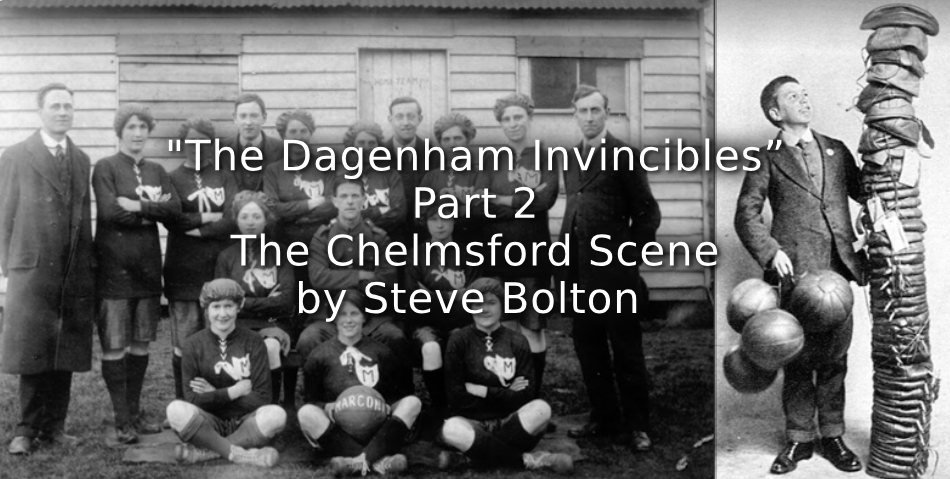
![“And then we were Boycotted”<br>New Discoveries about the Birth of Women’s Football in Italy [1933] <br> Part 8](https://www.playingpasts.co.uk/wp-content/uploads/2020/12/Boycotted-Marco-Part-8-440x264.jpg)



My Nan is part of the ladies sterling team, the Dagenham invincible, her name is Maud Billet
Hi Margaret – How fantastic. If you would be happy I would love to talk? My email is lizzyashcroftfootballer@gmail.com
Steve